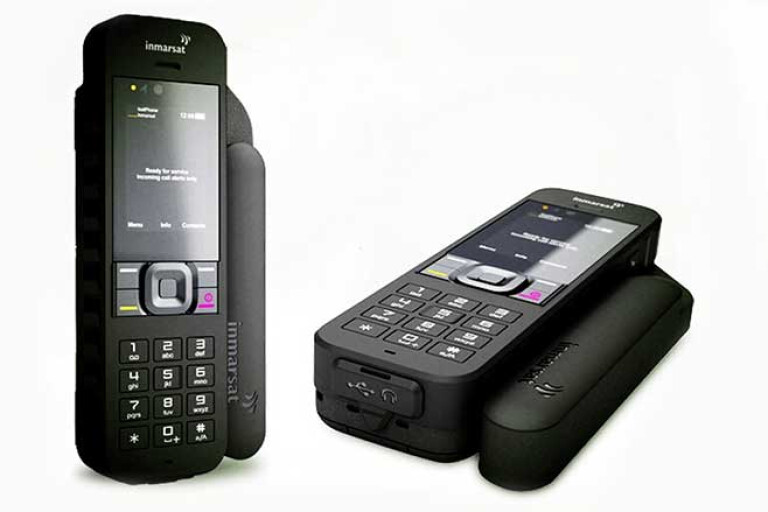.jpg)
WE RECENTLY delved deep into the world of satellite messengers, the trusty little devices that’ll keep you in contact with loved ones and emergency services when you’re beyond the range of phone reception. A similar device, albeit one that packs even more features into its compact size − and with a few more dollars tacked on too − is the satellite phone.
“With large areas of Australia’s land mass not covered by traditional mobile networks, including many popular travel destinations, satellite phones are a cost-effective communication option for coverage right across Australia,” said Kieran Blakemore from Pivotel, an Australian owned and operated company that specialises in remote communications.
The most obvious benefit of a satellite phone when compared to a satellite messenger is that, in addition to sending and receiving SMS messages, users can now (quite clearly) make and receive calls.
Much like messengers, most sat phones also have an inbuilt, monitored SOS facility for emergencies, because, as Reiny Gajewski − the VP of global sales for Beam Communications (a leading Australian developer of satellite communication solutions), as well as the general manager of the online business, the SatPhone Shop − reminds us: “Many roads and tracks across Australia are frequently visited and, should you break down, it could be days or even weeks before someone passes. Also, Australia has some of the world’s most dangerous animals, so emergencies can happen quickly.”

In addition to communicating with family and friends, as well as staying in touch with emergency services, a sat phone is also a great tool to stay up to date on weather reports, as well as to stay on top of emails ... not that we’d be checking emails out beyond the black stump.
They’re easy to use and set up, too, with a common misconception by the public of being hard to operate. In fact, satellite phones have come a long way in recent years and they are now as easy to use as a mobile phone.
“When you’re in a remote area a satellite phone really does provide you with peace of mind knowing if you need it, you have it,” Blakemore said. “Satellite phones allow you to keep in touch with family while you’re off the beaten track, let your family and friends know that you’re okay, keep them up-to-date with your latest plans and adventures, or, if the worst should happen, allow you to contact emergency responders, all from one device.”
COVERAGE
LOOK at a mobile phone coverage map and you’ll notice that most of Australia miss out on network coverage from the big telcos. In fact, as Reiny Gajewski explained, mobile carriers talk about coverage with regard to population, not land mass. So with most of Australia’s population in the big cities and regional centres, nearly 80 per cent of Australia has no mobile coverage at all.
Considering the important tidbit of info that mobile networks only cover around 20 per cent of the landmass of Australia, it’s important to opt for a satellite phone if you end up venturing to the ‘other 80 per cent’.
When looking at satellite coverage, there are multiple networks in Australia including Iridium, Inmarsat and Thuraya, with the Iridium and Inmarsat networks providing 100 per cent coverage in Australia.

“The Iridium system uses 66 Low Earth Orbit (LEO) satellites 800km above that are constantly moving as the earth turns,” Gajewski said. “So, the satellite footprints overlap one another, to ensure that you have a connection always.”
Blakemore added: “LEO satellite networks are made up of a constellation of small satellites that orbit the Earth in a series of planes. In each plane a number of satellites follow each other as they orbit the Earth, and the planes run parallel to each other to provide the radio coverage that is used for the services.
“The orbiting pattern of LEO satellite networks means that the individual satellites in the constellation are constantly moving relative to the Earth’s surface. From most locations it is possible to see one or more LEO satellites at any time.”
As satellite communication requires a direct line of sight between the satellite and the sat phone, having satellite footprints overlapping each other will ensure a constant connection, despite physical barriers like mountains that block the signal.

As Blakemore explained though: “As LEO satellites are always moving, the satellites may move out from behind the physical barrier after a few seconds or minutes providing a clear radio path between the user terminal and the satellite.”
Due to this, the Iridium network is the only network that provides complete global coverage, which means it’s also quite a bit dearer.
The Immarsat and Thuraya networks both operate Geostationary (GEO) satellite networks – a smaller number of satellites than the Iridium network, with each satellite providing coverage to a fixed area.
GEO satellites are larger but are located some 36,000km above earth, so there is greater voice delay than LEO satellites. “When using GEO satellite phones they must be pointed in the correct direction relative to where the satellite it positioned, it is preferable to have a high elevation angle,” Blakemore said.
What about UHF radios, we hear you ask? “A UHF radio only goes a max of around 18km, so if there is no one else in that range, then you are on your own,” Gajewski said.
That leaves satellite as the only reliable communication platform across Australia, for when the tracks get seriously remote.
KEY FEATURES TO LOOK FOR
INDIVIDUAL budgets will dictate the extent of the features embedded within the satellite phone, but non-negotiables should include a long battery life; inbuilt SOS functionality; and a rugged, durable and water-resistant construction.
BEFORE you sign on the dotted line for a new satellite phone, it’s important to establish where you intend to travel to and ensure said device is on the correct satellite network for your chosen course. It’ll be as useful as a brick if it can’t find a network. Also decide whether you intend to make phone calls to the outside world when on a trip. If not, perhaps a satellite messenger is a cheaper alternative.

GETTING a sat phone with an Australian number (if feasible) instead of an international satellite number is highly recommended, too. “Australian ‘04’ numbers, and all of the benefits associated with this feature, can be more important than the hardware itself,” said Kieran Blakemore. “This
can ensure your monthly costs are kept low.”
OTHER features to look for include internet connectivity for specific applications, smartphone connectivity, whether the product supports a range of accessories (docking units, external antennae,
etc.) and good deals on plans come purchase time.
SMARTPHONES
THERE are particular satellite phones available − the Thuraya SatSleeve and Iridium GO!, for example − that basically turn a user’s smartphone into a satellite device. Commonly known as ‘smartphone extenders’, the satellite device connects to a smartphone via WiFi, allowing the phone to act as a satellite device via an installed phone application.
“These devices have additional features like email and have other useful features like accessing certain low bandwidth apps, as well as your existing contact list from your mobile phone, making it easier to call without having to re-enter phone numbers into another device,” said Kieran Blakemore.
WHAT TO AVOID
SAT phones have aged poorly, so it’s important to avoid purchasing an old, outdated phone, as it probably won’t do what it’s meant to do when you need it most.
This also applies to buying a second-hand phone from the World Wide Web that’s out of warranty, as you’ll be cursing the gods when you’re axle-deep and there’s no help within cooee. Plus, it’s considerably harder to find replacement parts − e.g. batteries − for older phones.
With more than 20 years of experience in the satellite industry, Reiny Gajewski, as mentioned, also told us to avoid buying international satellite numbers (if you can), as the phone bill becomes very expensive for people who call you.
“Telstra offer a local ‘01471’ prefixed number which means all incoming calls and SMS are free to receive and the caller pays substantially lower rates to call you compared to a full international satellite number. The Telstra number also gives you access to call 13, 1300 and 1800 numbers from your satellite phone.”
Kieran Blakemore reiterated that point: “The benefits or purchasing a device with an Australian ‘04’ mobile number cannot be dismissed,” he said. “The ‘04’ mobile number means incoming calls and SMS are charged at standard Australian mobile rates, which means the calls are usually free to the caller as most mobile phone and landline bundles provide unlimited standard mobile phones calls. They’re also a lot easier to dial.”
With plans − called Airtime Plans − and prepaid options available, Gajewski advises to avoid buying the wrong plan: “Try to work out over a 12-month or 24-month period how many times and for how long in each instance will you need the phone.”
HOW MUCH COIN ARE YOU LOOKING AT?
TO GET on to the Iridium network you’re looking at about $45 to $60 per month, with hardware (Iridium GO!) priced at $1145 to $1299. Telstra offers a Mobile Repayment Option, so be sure to research before you buy.Opting for the Immarsat network starts at $37 per month, with the Immarsat IsatPhone 2 priced at $1249. While the Thuraya network starts at $15 per month, with hardware (Thuraya XT-LITE standalone smartphone and the Thuraya SatSleeve) priced at $899.
DUAL-MODE SATELLITE SMARTPHONE
THERE is also a dual-mode satellite smartphone available on the market, which can hold a cell SIM card and a satellite SIM, and it’ll automatically switch to the network that has coverage. “This means you only need one device instead of both a mobile phone and a seperate satellite phone,” Blakemore said.\



COMMENTS